HOW TO FIND THE DOMAIN AND RANGE FROM A RELATION
Subscribe to our ▶️ YouTube channel 🔴 for the latest videos, updates, and tips.
Let A and B be any two non empty sets. A function f from A to B is a rule of correspondence that assigns each element x ∊ A to only one element y ∊ B. We denote y = f(x) to mean y is a function of x.
The set A is called the domain of the function and set B is called the co-domain of the function. Also, y is called the image of x under f and x is called the pre image of y.
The set of all images of elements of A under f is called the range of f .
Note that the range of a function is a subset of its co-domain.
How to check whether a relation is a function?
Let f be a relation from A to B. The relation f to be a function, it has to satisfy the following two conditions.
(i) All the elements of A must have images in B.
(ii) Each element of A must have only one image in B.
Note :
1. When a relation is defined from A to B, if anyone of the element of A does not have image in B, then the relation is not a function.
2. And also, if anyone of the element of A has more than one image in B, then the relation is not a function.
Let f1, f2, f3 , f4 and f5 be the relations defined from A to B. If A = {1, 4, 9, 16} and B = {–1, 2, –3, –4, 5, 6}, Which of the following relations are functions ? In case of a function, write down its domain and range.
Example 1 :
f1 = {(1, –1), (4, 2), (9, –3), (16, –4)}
Solution :
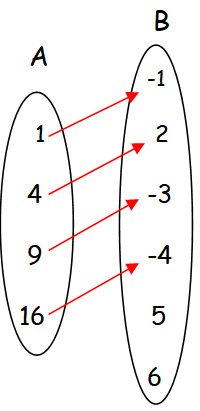
In the above arrow diagram, each element of A has image in B and also each element of A has only one image in A.
So the relation f1 is a function.
Domain is the elements of A.
Domain = {1, 4, 9, 16}
Range is the elements of B which have preimages in A.
Range = {-1, 2, -3, -4}
Example 2 :
f2 = {(1, –4), (1, –1), (9, –3), (16, 2)}
Solution :
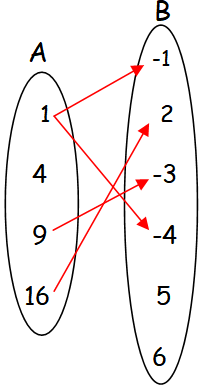
In the above arrow diagram, element 4 in A does not have image in B.
So the relation f2 is not a function.
Example 3 :
f3 = {(4, 2), (1, 2), (9, 2), (16, 2)}
Solution :
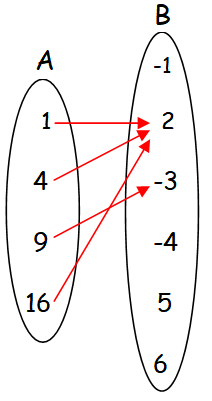
In the above arrow diagram, each element of A has image in B and also each element of A has only one image in A.
So the relation f3 is a function.
Domain is the elements of A.
Domain = {1, 4, 9, 16}
Range is the elements of B which have preimages in A.
Range = {2, -3}
Example 4 :
f4 = {(1, 2), (4, 5), (9, –4), (16, 5)}
Solution :
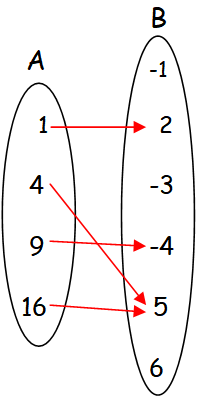
In the above arrow diagram, each element of A has image in B and also each element of A has only one image in A.
So the relation f4 is a function.
Domain is the elements of A.
Domain = {1, 4, 9, 16}
Range is the elements of B which have preimages in A.
Range = {2, -4, 5}
Example 5 :
f5 = {(1, 2), (4, -3), (4, 5), (9, –4), (16, 5)}
Solution :
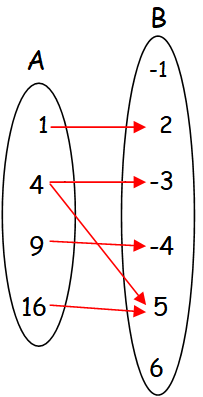
In the above arrow diagram, each element of A has image in B. But the element 4 in A has more than one image in B (two images -> -3 and 5).
So the relation f5 is not a function.
- Copy and complete each input-output table.
- Find the domain and range of the function represented by the table.
Example 6 :
y = 3x + 4

Solution :
|
When x = -2 y = 3(-2) + 4 = -6 + 4 = -2 |
When x = -1 y = 3(-1) + 4 = -3 + 4 = 1 |
|
When x = 0 y = 3(0) + 4 = 0 + 4 = 4 |
When x = 1 y = 3(1) + 4 = 3 + 4 = 7 |
When x = 2
y = 3(2) + 4
= 6 + 4
= 10

Example 7 :
y = (1/2)x - 6

Solution :
|
When x = 0 y = (1/2)(0) - 6 = 0 -6 = -6 |
When x = 1 y = (1/2)(1) - 6 = (1 - 12)/2 = -11/2 |
|
When x = 2 y = (1/2)(2) - 6 = 1 - 6 = -5 |
When x = 3 y = (1/2)(3) - 6 = (1 - 18)/2 = -17/2 |
When x = 4
y = (1/2)(4) - 6
= 2 - 6
= -4

Example 8 :
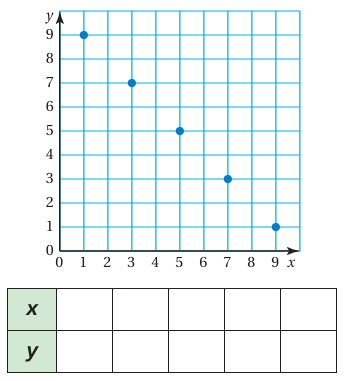
Solution :
Set of ordered pairs from the points plotted,
(1, 9) (3, 7) (5, 5) (7, 3) (9, 1)
The values of x are :
1, 3, 5, 7, 9
The values of y are :
9, 7, 5, 3, 1
Subscribe to our ▶️ YouTube channel 🔴 for the latest videos, updates, and tips.
Kindly mail your feedback to v4formath@gmail.com
We always appreciate your feedback.
About Us | Contact Us | Privacy Policy
©All rights reserved. onlinemath4all.com

Recent Articles
-
10 Hard SAT Math Questions (Part - 40)
Dec 25, 25 08:30 AM
10 Hard SAT Math Questions (Part - 40) -
10 Hard SAT Math Questions (Part - 41)
Dec 24, 25 07:58 PM
10 Hard SAT Math Questions (Part - 41) -
ASTC Formula in Trigonometry
Dec 23, 25 11:34 PM
ASTC Formula in Trigonometry - Concepts - Examples and Solved Problems


